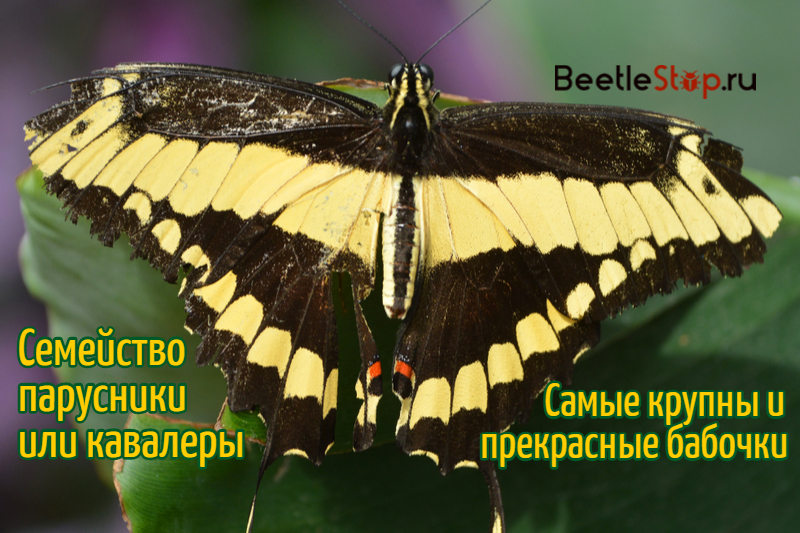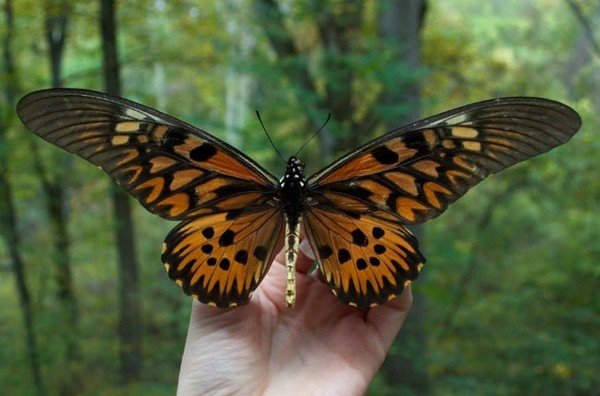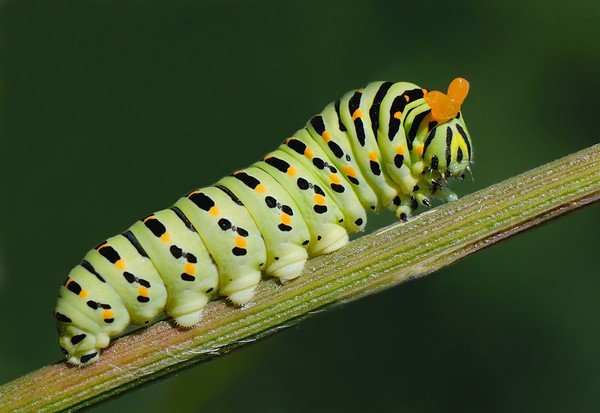Secrets of Large Insects: Butterfly Sailboat
Representatives of the family sailboats are rightfully considered the most striking and largest butterflies. They attract attention with an unusual combination of colors and the original shape of the wings. A butterfly sailboat can catch the eye of a curious observer anywhere in the world. About 20 species live in Russia, some are listed in the Red Book. One of the interesting features of sailboats is the tail tails. This detail distracts the attention of birds, saving the life of a butterfly.

Family Description
Sailboats or gentlemen (Papilionidae) combined medium and large butterflies. The wingspan of the representatives of the family 65-280 mm. Individuals with striking body and wing dimensions live in the tropics. In palearctic species, the pattern of the wings consists of black fields, dressings and spots on a yellow or white background. Red and blue spots dilute the palette. The head is round, the eyes are faceted, bare. Short antenna club-shaped. Walking legs are well developed.
Fore wings are triangular, hind oval. The outer edge is wavy, in many species there are outgrowths in the form of tails. A characteristic feature of the family is that the hind wings have a neckline, so they do not lie on the abdomen. All butterflies are active during the day, in sunny weather. Most of them produce one generation in a year, and two in the southern regions.
Interesting fact. The sailing Apollo Hanington lives in the Himalayas at an altitude of 5-6 thousand meters above sea level.
All members of the sailboat family are divided into three subfamilies:
- Baroninae - consists of one relict species of Baronia, common in Mexico. This butterfly sailboat in the photo is the oldest representative of the club-headed Lepidoptera today.
- Parnassiinae - includes 8 genera and 480 species living in North America and Eurasia. Caterpillars are oliphages and monophages, their life is associated with a particular feed plant. Among them: Apollos, Sericinmontela, butanitis, three-tailed sailboat).

Butanis - Papilioninae is a large subfamily of 22 genera, the majority lives in the tropics, the rest are found everywhere. Large medium butterflies are distinguished by a variety of wing coloration. This group includes tail nests, parides (sailboats without tails), teinopalpus - one of the most beautiful butterflies in the world.

Theinopalpus
A huge family of sailboats is divided into genders. One of them is Papilio or Tail. The group includes almost 200 species of butterflies, including swallowtail, Maak sailboats, zalmoksis, Aleksanor, Corsican. This genus includes the antimach sailboat - the largest butterfly on the African continent. Its wingspan is 20-23 cm. Unlike many species, males are larger than females, in some cases they reach 25 cm. The main background of the wings is orange or buffy, the pattern is formed by dark brown stripes and spots.

Caterpillars
The larvae of the species are as diverse as adults. They differ in size, color, choice of fodder plants. But all the caterpillars of the butterfly of a sailing ship are united by an interesting anatomical feature. They have an unusual organ - a fork-shaped saccular gland. It is called osmetry and is located in the prothoracic segment.In case of danger, the caterpillar pushes orange horns. A secret with an unpleasant pungent odor is released from the gland. Larvae of early ages use osmetry. Adult caterpillars do not push out the gland. In addition to sailboats, only the crested butterfly has a similar organ.

Distribution area
The sailing family lives worldwide in 6 geographical areas. The largest specimens are found in the tropics. Sailboats can be found at the border of the Arctic Circle and high in the mountains.
Butterflies sailboats photo with names
One of the largest families of Lepidoptera insects with almost 600 species includes many interesting specimens.
Queen Alexandra's Birdwing
The world's largest day butterfly with a wingspan of 28 cm. Its homeland is the tropical forests of New Guinea. The species has pronounced sexual dimorphism. The female is much larger, brown and cream color predominates in her color. Male up to 20 cm in size has narrow blue-green wings. The number of butterflies is limited, due to the destruction of natural habitats, they have become an endangered species.

Apollo
Many representatives of the Apollo species of the genus Parnassius are listed in the Red Book of Russia and European countries. A daytime butterfly with a wingspan of 65-90 mm is found on the dry edges of pine forests, clearings, alpine meadows. They settle in the mountains of Europe, southern Scandinavia and the Urals, in the Caucasus, southern Siberia, and Mongolia. The main color of the wings is white; a gray stripe runs along the outer edge. Black spots are visible on the upper pair of wings, and red with a white middle on the lower. Caterpillars develop on stonecrops.

Interesting fact. An alarmed butterfly falls on its back, scratches its legs and makes a hissing sound.
Swallowtail
Papiliomachaon is the most common type of sailboat in the European part of the Russian Federation. Wingspan in males is up to 80 mm, in females - up to 95 mm. Against a bright yellow background, the front wings are covered with a pattern of black spots and veins. Along the edge is a black border with bright dots. The hind wings are colored with blue and yellow blotches, as well as a red eye at the inner corner. The subspecies of the Machaon live in the south of Siberia, in the Amur region, on Sakhalin, in Japan. In the north of Europe, one generation appears annually, and in Africa - three. The life expectancy of adults is about 3 weeks.

The caterpillar is green with black stripes and orange spots. Feed plants: hogweed, parsley, dill, celery.
Sailboat Rumyantseva
The butterfly was discovered by the Russian natural scientist I. Eshsholts. Its name is dedicated to Count Rumyantsev, who financed the scientific expedition. Butterfly habitats Sailboat Rumyantsev - Philippines, Java, Indonesia, Borneo. The wingspan of the butterfly is 12-14 cm. The front wings of the males are black with silver-gray scales along the veins. On the hind wings, the spraying is blue-gray. A garland of bright pink or yellow spots runs along the bottom edge. Females are much more attractive, the black background of the wings is diluted with raspberry patches at the base. In many specimens, the inner part of the hind wings is white with black veins, pink spots on the bottom. Caterpillars feed on perennial plants of the Kirkazon genus.

Sailboat Palinur
Papiliopalinurus butterfly or Palinur sailboat inhabits the tropics - Burma, Malaysia, Indonesia. For their bright green color they are called emerald princesses. The size of the insect is 8-10 cm. The wings are black, but some of the scales are green. In the middle are wide oblique stripes of light green color. Ponytails on hind wings extended. On the underside of the wings is a contrasting gray-brown color. Larvae feed on citrus fruits.

Tailing Maak
Sailboat Maak - the largest butterfly in Russia among Lepidoptera, active in the daytime. The species owes its name to the Russian naturalist, explorer of Siberian open spaces, Richard Karlovich Maak. The wingspan of adults is 12-14 cm. Their color seems blue-green.For a rare shade and red spots on the end of the hind wings, the insect was called the blue swallowtail. Fore wings consist of black and green scales. Along the edge there is a wide, blurry transverse strip of a light green hue. The hind wings are green with a blue tint of black bandages.

The color of the females of the butterfly, the tail of the Maak, is diverse, it is difficult to find two identical specimens. Usually the front wings are black or brown, without green scales. On the hind wings at the outer edge, red spots are pronounced. Insects live in Transbaikalia, Amur Region, Sakhalin, Central Asia, Japan, South Korea. They settle in broadleaf and mixed forests. Males gather in groups of several dozen individuals on the wet banks of the rivers. Females keep aloof. Feed plants - Amur and Sakhalin velvet. Alarmed caterpillars push the odorous gland of osmetries from behind their heads. Butterfly is listed in the Red Book of Sakhalin Oblast.

An interesting fact is that the butterfly sailing Maak for a year gives two generations, adults born in the summer are 1.5 times larger than spring relatives and have a darker color.
Sericinusmontela
Sercinmontel butterfly is the only representative of the genus Sericinus. She lives in the Primorsky Territory, China and the Korean Peninsula. The male’s wings are white; on the front, the pattern consists of black spots and darkening in the upper part. At the end of the hind wings there is a large red spot with a brown border. Ponytails noticeably elongated. Females have brown wings with yellow wavy bandages. The edge of the hind wings is covered with red and blue spots. The size of the butterfly is 65-70 mm. Females fly poorly, spend a lot of time in the grass. Fodder plant kirkazon. The species is listed in the Red Book of Russia, the limiting factor is the destruction of the food supply.

Sailboat Ulysses
The Uliss butterfly sailor lives in tropical rainforests and on the hills up to 800 km. It is found in northern Australia, in Indonesia, New Guinea, and on the Solomon Islands. Females are shy, more active in the afternoon. Males gather at ponds and replenish mineral reserves by sucking water from moist soil. The background color of the wings is black. The area from the base almost to the edge of the wings is occupied by blue or blue fields. The tails of the hind wings are widened at the edges. Protective color on the underside of the wings of brown shades. Edge ocher spots on the hind wings emphasize light bordering. Fodder plants of caterpillars belong to the rutov family.

Interesting fact. The males of the Uliss sailboat actively react to blue objects, mistaking them for females. This is used by butterfly catchers, they wave the bait, then cover the net with a landing sailboat.
Sailboat Kotzebue
The butterfly owes its name to the commander of the Russian research vessel Rurik Otto Kotzebue. The insect is found in the Philippines. 5 subspecies of the insect are known. The scientific name for the Kotzebue butterfly is Pachliopta Kotzebua. Its wingspan reaches 13-15 cm. The body of the sailboat is red with black spots. This is a warning signal to birds about the toxicity of an insect. The main color of the velvety wings is black. In females, white transverse bandages are observed. On the inside of the hind wings there is a scattering of red spots resembling a heart shape. At home, the butterfly is called a "velvet scarlet rose." The life expectancy of adults is 7 days.

Papilio lowi
Butterfly sailboat Catch or Asian dovetail lives in Borneo, Philippines and Indonesia. The insect is named after the English naturalist Sir Hugh Lowe. The butterfly belongs to the middle species with a wingspan of 11-12 cm. The main color of the wings is black, on the front there are interspersed gray stripes. At the base of the wings are red patches. In the color of the females there are beige, orange and purple tones. On the flowers they sit spreading their wings, showing the world their beauty.

Caterpillars of this species feed on citrus plants of the root family. The life span of an imago is one week.Often he buys beautiful butterflies for house maintenance, with good care, the Lovi sailboat lives 2-4 weeks. They eat juice of oranges and 10% solution of natural honey.


 (votes: 10, average rating: 4,60 out of 5)
(votes: 10, average rating: 4,60 out of 5)